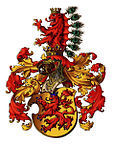Categories Online-Shop Germany German States until 1871 Habsburg House of Habsburg
House of Habsburg

The House of Habsburg is a European dynasty whose name derives from its ancestral stronghold Habsburg in today's Swiss canton of Aargau. Members of the dynasty were first in 1273 and almost continuously from 1438 the German kings and Roman-German emperors and ruled from 1282 on the duchies of Austria and Styria (Austria) and from 1438/1527 on Bohemia, Croatia and Hungary.
In the 16th century, the dynasty divided into a Spanish line that ruled over Spain and Portugal and their overseas possessions and whose male line died in 1700 with Charles II. And in an Austrian line, which male line ended in 1740 with Charles VI, but was continued by the descendants of Maria Theresa and Francis of Lorraine as Habsburg-Lorraine.
From this new house came the Roman-German Emperor Francis II, who in 1806 was forced by Napoleon to lay down this crown and dissolve the Holy Roman Empire. He proclaimed - now as Francis I - proclaimed the hereditary empire Austria to maintain equality of rank with Napoleon. The Empire of Austria encompassed all Habsburg ancestral lands. In 1867 the conversion to the Austro-Hungarian monarchy took place; this crumbled with the end of the First World War in 1918.
In the early Middle Ages, the mint masters from the House of Habsburg struck, above all, silver pennies. Due to the geographical situation wedged between the German lands in the north and the Italian cities in the south they began early with the coinage of shillings, groschen and gold guilders. Thus, the Habsburg rulers managed to position themselves favorably in the long-distance trade. By the end of the 16th century at the latest the mints coined mainly thalers. The thaler was to remain the most significant coin of the Habsburgs until the end of their reign.


